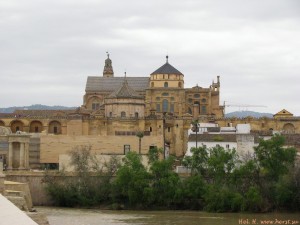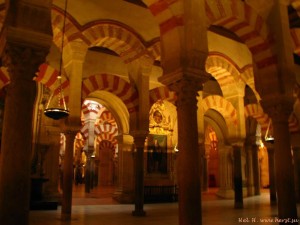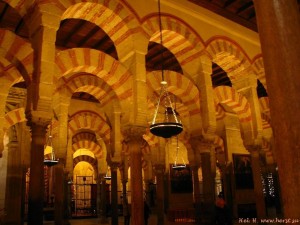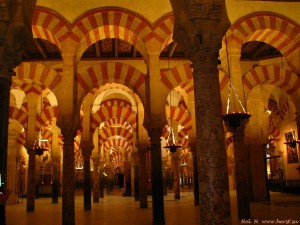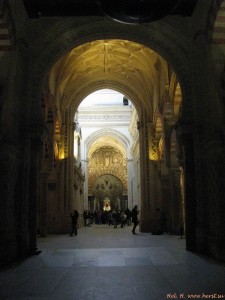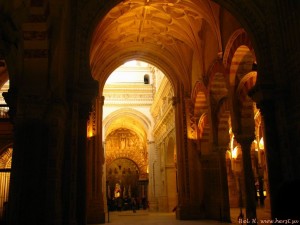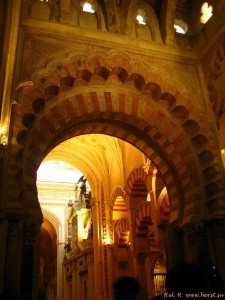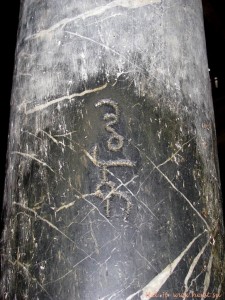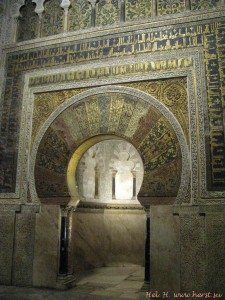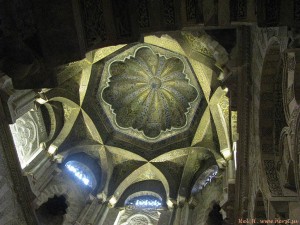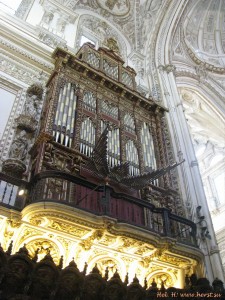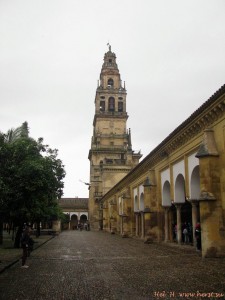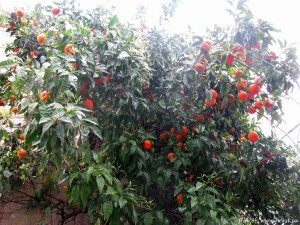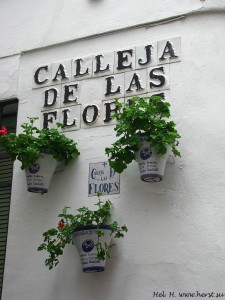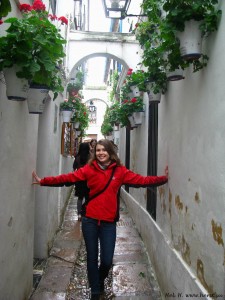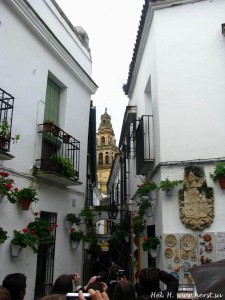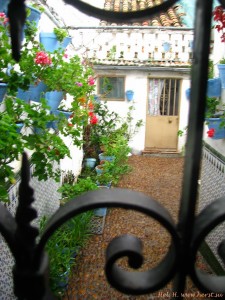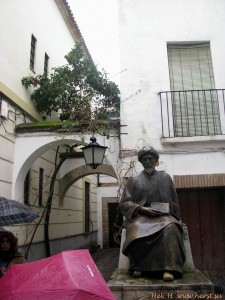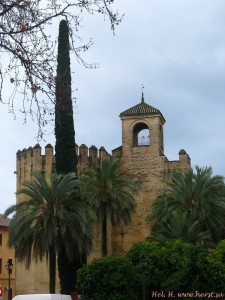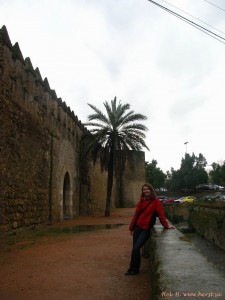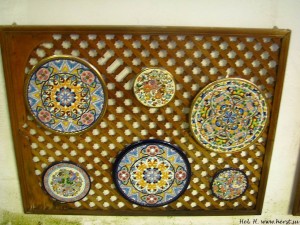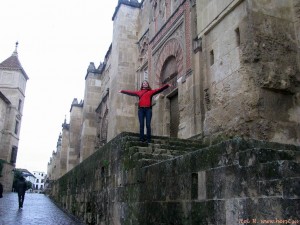On March 11th of 2011, I went to the south of Spain, to Andalusia region. This was my first trip, organized not by myself or my friends, but by the organization of European exchange students ESN.
Early in the morning (about 9) a bus full of students of the Carlos III University started from Madrid. After a five hour journey we arrived in Córdoba — the antique city, known for its grandiose cathedral mosque, called Mezquita ( from spanish mezquita = «mosque»).
Once known as the world’s largest city (approx. 1 million inhabitants in 10th century), Cordoba dates back its history to the second century BC and is now the third largest city in Andalusia (328.5 thousand inhabitants).
During this long time Cordoba changed many owners. Romans, Byzantines, Western Goths, Moors, and finally, the Spaniards – were changing each other, leaving imprints on its architecture and culture of its people. Jews, Muslims and Christians used to live together in ancient times in a small town between Europe and Africa. The combination of these cultures is nowadays still clearly visible in the city appearance.
Cordoba has many prominent sons like Lucius Annaeus Seneca — Roman philosopher and writer, well known by his tragedy «Medea.»
When the bus stopped at a special parking place, we had to cross the old Roman bridge that leads into the historic center of Cordoba.
After leaving our stuff at the hostel, we went out to search for lunch, what wasn’t the best option in the touristic heart of the city.
Spanish meal and traditions connected with it are a special topic. For lunch you usually get three meals – the first course is a salad, a soup or something heavier (spaghetti, steamed vegetables, fries potatoes ). The second is usually some meat or fish with vegetables. Sometimes it turns out that you actually eat two times the second plate. The third is a dessert – something sweet or fruits.
Each restaurant has a special lunch time menu — a combination of three dishes at an economical price. It includes one drink, the first and the second courses, and a dessert or a coffee. All this you can get for 7-8 euro (if you have luck).
In Cordoba we found such an economical option. At first I had a cold tomato soup gazpacho, for the second sheep meat with salad and potatoes. After a 5-hour bus trip, we requested also a dessert. Not like our expectations of getting a homemade sweetness, we were brought some supermarket plastic cups of ice cream, pudding or yogurt. No one gave up even this dose of sugar though.
After the lunch we started our rainy city tour.
As I’ve already mentioned, Cordoba is famous for its great mosque, which is considered as one of the most important monuments of Spanish-Muslim architecture and nowadays announced as the UNESCO world’s culture heritage.
Mezquita’s building process started in 786, at the place of an ancient Visigoth basilica. Changing leaders of Moorish Umayyad dynasty enriched the Mosque, which has been the most luxurious of more than 1000 mosques of Cordoba at the time. This way in Mezquita there are 1300 pillars of marble, onyx and granite, “borrowed” from the ruined buildings of Roman and Visigoth cultures. The columns are connected by brick and stone bindings what provides a secure base for the building.
In 1236 Cordoba was conquered by the Spanish King Ferdinand III of Castile and the mosque began its transformation into a Christian cathedral. 1523 started the construction of a basilica in style of Renaissance right in the heart of the Muslim building. Architects continued to change the structure of the building until the end of the 18th century. The good thing is that the architects didn’t destroy the mosque built earlier, they just continued the works in their own way. Thus, Mezquita is the unique mix of Muslim and Christian architectural motifs.
Our guide, a middle-aged quickly Spanish-speaking woman, showed us the halls of the mosque. This way we saw the very beginning of Mezquita — a piece of the floor of Visigoth basilica, the most beautiful oriental motifs and the hall, which is similar to all Catholic churches.
Unfortunately, we weren’t given the time to look around in the mosque on our own since our guide was in a hurry to show us the city and get rid of her professional duties.
I didn’t want to go out from the magnificent building. Outside we were expected by the rain, which didn’t allow us to enjoy a large garden with orange trees in the mosque court.
Orange trees are not uncommon in southern Spain — there grow along the roads and in each yard and garden. Every tourist feels obliged to pick an orange from the tree, but after trying a bit throws it away since it’s really bitter.
Few minutes later we walked through the narrow streets, looking into every courtyard. The local courts called “el patio” are the pride of their owners. Every April there’s a «Battle of flowers” in Cordoba (Batalla de las flores) – a championship for the most beautiful patio during which the courts look especially chic.
Since the weather certainly didn’t invite to take a walk, most of the students of our group went on a tour through the bars of Cordoba. “There is no bad weather, there are bad clothes”, — I thought and went for a walk through the local streets joined by a couple of desperate mates, looking into the churches and indefinitely colored patio.
Besides Mezquita Cordoba has something else for its visitors. There are some remains of an ancient Roman temple, the Alcazar palace, and not far from the city there is an ancient town Medina Al-Sahara. We didn’t have time to enjoy all of these monuments though. We spent in Cordoba less than a day, and already next morning the bus was taking us from the still-rainy Cordoba to the sunny and passionate Seville. Another city, which I will definitely dedicate an article to.
